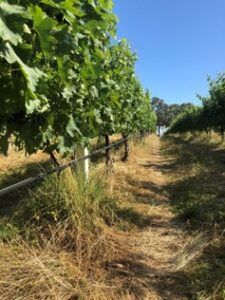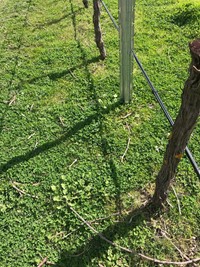Background
Mid-row cover crops (permanent swards and annual cover crops) are commonly used in vineyards to improve soil health and manage weeds. More recently, researchers and growers have started to trial cover crops as a way to control weeds undervine. In suitable environments, the correct species of cover crop can effectively suppress the growth of other plants.

Figure 1. Ryegrass undervine cover crop suppressing kikuyu in a McLaren Vale vineyard (courtesy of Troy Elliker, Gemtree)
Action
Actively growing cover crops compete with weeds for water and nutrients. Cover crops also suppress weed seed germination by blocking sunlight from reaching the soil surface (Figures 1 and 2). Some cover crop species, such as barley and cereal rye, produce allelochemicals which suppress weed growth (Figure 1).
Cover crop residues remaining after senescence suppress weeds during summer when retained as a surface mulch. Mid-row cover crop residues can also provide some weed control when mown and thrown undervine.

Figure 2. Undervine clover in the Barossa (image courtesy of Karl Schiller)
Advantages and disadvantages
Advantages: In addition to weed control, cover crop species or mixes of species can be sown to provide a variety of benefits. For example:
- Leguminous species such as faba beans, field peas, vetches, lupins, clovers subclovers and medics fix nitrogen in the soil. A legume crop can add 100 kg of nitrogen per hectare of cover crop when incorporated into the soil.
- Flowering species such as alyssum, phaselium, buckwheat, wallaby grass, windmill grass, Queensland bluegrass, creeping saltbush and ruby saltbush attract beneficial insects.
- Species of brassica and legumes with deep taproots, such as fodder radish, faba beans and lupins, are good at breaking up hard pans and heavy soils.
- Cereals and grasses with fibrous root systems, such as cereal rye, triticale, annual rye grass, perennial rye grass and tall fescue, improve soil structure, soil organic carbon levels, water infiltration rates and reduce soil erosion.
- Generally, the use of cover crops results in an increase in soil microbial diversity, soil microbial biomass and activity in soil top layers (0-5 cm) and earthworm numbers compared to managing weeds with herbicides or cultivation (Abad et al. 2021).
- Cover crops can also provide better access to the vineyard following rain or irrigation and may increase humidity and reduce vineyard floor temperatures.
- Cereal rye, triticale, oats, barley, fodder radish, oilseed mustard, established wallaby grass and creeping saltbush are all good weed competitors when managed appropriately (Nicholas et al. 2004).
Disadvantages:
- For undervine cover crops, significant site preparation and modified seeders may be required for good crop establishment.
- Permanent undervine cover crops may need to be resown every few years to maintain dominance over weeds.
- Perennial swards and annual grasses such as perennial ryegrass, tall fescue, cocksfoot, lucerne, chicory and annual ryegrass can all compete heavily with vines if not managed effectively, leading to reduced yields.
Table 1. Performance of undervine cover crops in achieving different outcomes
| Ability to reduce weed competition with vines | Good (when using weed-suppressing species) |
| Soil disturbance caused | Good (when using no-till practices) |
| Suitability in young vineyards | Good (when using short-season winter-active species) |
| Length of weed control | Good |
| Operating cost | Low |
| Capital cost | Low |
Note: environmental influences on cover crop performance will affect their weed suppression.
Considerations
Cover crops vary widely in their characteristics and a range of factors must be considered when choosing species, especially for the undervine area. These include:
- selection of short-season annual grass and legume species which complement the vines’ water and nutrient requirements
- irrigation rate
- availability of tillage, seeding and mowing equipment
- the risk of fire and/or frost.
Table 2. Ease of establishing undervine cover crops on different soil types
| Large or excessive stones | Moderate |
| Stone/gravel | Easy |
| Sand | Easy |
| Silt/loam | Easy |
| Clay | Easy |
Cover cropping tips
- Use the cover crop finder tool developed by Wine Australia in partnership with University of Adelaide, to help select an appropriate cover crop species or mix to suit your desired outcomes, site conditions, budget and availability of seed.
- Consider sowing a mixture of at least two varieties with early to mid-maturity, which will help overcome seasonal and soil variability.
- Good weed control prior to sowing a cover crop is essential for good crop establishment. Weed control should be conducted as close as possible to the time of sowing to give the crop a chance to establish before the weeds start to grow again. Undervine cultivation can provide good weed control pre-sowing in situations where herbicides cannot be used. Weeds that start to grow in the undervine area before the crop has germinated can be managed by mowing.
- Mow or cultivate the cover crop before bud burst in frost-prone areas or leave it to ‘hay off’ if frost risk is low, soil moisture is adequate and crop growth does not reach the canopy. Mowing reduces soil disturbance and preserves soil organic carbon levels. Undervine sweeping can be used to pull the crop away from the canopy without disturbing the soil.
- Where possible, delay mowing until after cover crops have flowered and set seed to encourage regeneration, especially with annual species.
- Resow sparse patches of cover crop to increase ground cover and improve weed suppression.
- After mowing, leave clippings undervine to provide a mulch. The most persistent mulch will be provided when stem material has lignified prior to mowing.
- Sward biodiversity allows greater adaptability to the site and usually produces a more consistent and greater biomass. The species chosen should have complementary growth habits.
Growers’ experiences
In Margaret River, WA, the climate is Mediterranean, with the majority (75%) of the average annual rainfall (1,146 mm) falling in winter and summers are generally dry and warm. In this region, Vasse Felix recognises the benefit of growing a cover crop undervine for weed suppression and to improve soil health.
Instead of using an undervine seeder, Vasse Felix mows and throws its permanent mid-row sward, after the sward has flowered and set seed, to establish an undervine cover crop.
Vasse Felix uses a mix of two types of clover, annual rye grass, low growing oats, medics, and perennial rye grasses in its permanent swards. In most years, the oats and ryegrass ‘hay off’ towards the end of spring to create an undervine mulch. In wet years, undervine sweepers are used to pull the undervine crop out of the vine canopy. Sheep grazing is used at a higher vigour site to manage cover crop growth during the winter months.
Moving away from herbicides and maintaining plant cover across the whole vineyard has increased soil organic carbon levels by 150% with no major effect on yield or vine growth. In the future Vasse Felix plans to incorporate flowering species into its sward to attract beneficial insects.
Resources
Cover crops and weed suppression (Wine Australia fact sheet)
Cover crops and vineyard floor temperature (Wine Australia fact sheet)
Trialling undervine and mid-row cover crops (AWRI case study)
Abad, J., Hermoso de Mendoza, I., Marín, D., Orcaray, L., Santesteban, L.G. 2021. Cover crops in viticulture. A systematic review (1): Implications on soil characteristics and biodiversity in vineyard. OENO One, 55(1), 295–312.
Nicholas, P., Porter, R., Sanderson, G. 2004. Cover crops. Soil, irrigation and nutrition. Adelaide, SA: Winetitles.
Organic Winegrowers New Zealand. 2017. Undervine weed management – A practical guide to effective weed control in organic vineyards
Contact
For further information, please contact:
AWRI helpdesk
Phone 08 8313 6600 Email helpdesk@awri.com.au

